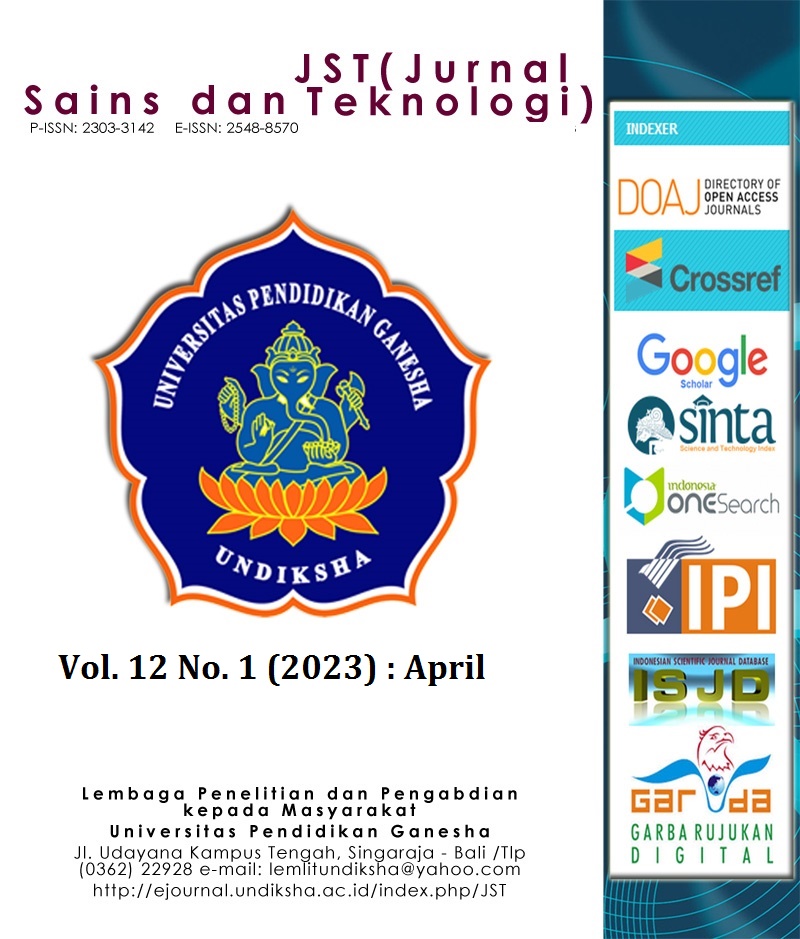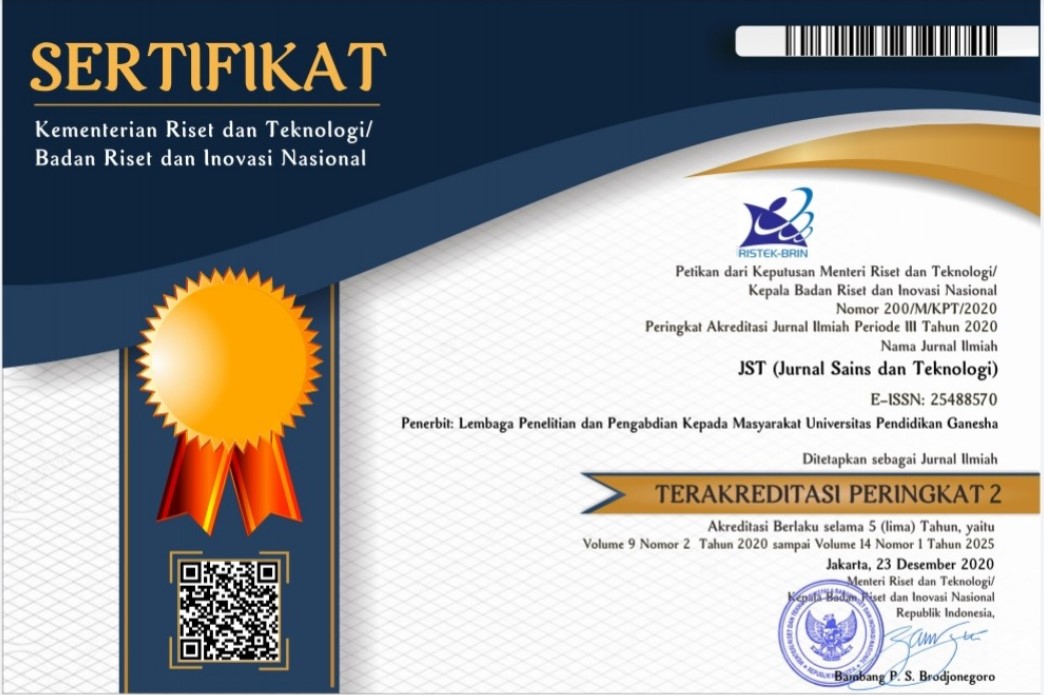CHROMOPHORIC DISSOLVED ORGANIC MATTER (CDOM) DAN NUTRIEN TERLARUT DI SUMBER AIR DI BALI UTARA
DOI:
https://doi.org/10.23887/jstundiksha.v12i1.59811Kata Kunci:
sumber air, curah hujan, chromophoric dissolved organic matter, nutrien terlarutAbstrak
Penelitian ini dilakukan dengan tujuan untuk menentukan absorbansi chromophoric dissolved organic matter (CDOM) dan konsentrasi nutrien terlarut di sumber air di Sanggalangit, Kecamatan Gerokgak, Kabupaten Buleleng yang terletak di Bali Utara, serta menganalisis pengaruh curah hujan terhadap sumber air ini. Subjek dalam penelitian ini adalah air yang diambil dari sumber air di Sanggalangit yang telah disaring menggunakan kertas saring GF/F 0,7 µm. Objek penelitian ini adalah absorbansi CDOM dan konsentrasi nutrien terlarut. Pengukuran absorbansi CDOM dan konsentrasi nutrien dilakukan dengan menggunakan instrumen spektrofotometer Ultraviolet Visible (UV-Vis). Dari nilai absorbansi yang diperoleh, kemudian dihitung parameter S275-295, S350-400, dan E2:E3. Hasil penelitian menunjukkan bahwa nilai dari S275-295 dan S350-400 menunjukkan kecenderungan nilai maksimum dan minimum yang terbalik dengan curah hujan. Curah hujan berpengaruh terhadap rasio E2:E3, tetapi tidak terlihat mempengaruhi konsentrasi nutrien terlarut (nitrat, nitrit, amonia, dan fosfat). Berdasarkan peraturan yang berlaku, kualitas air di sumber air Sanggalangit tergolong baik secara kimiawi.
Referensi
Birdwell, J. E., & Summers, A. (2010). Organic Geochemistry Characterization of dissolved organic matter in cave and spring waters using UV – Vis absorbance and fluorescence spectroscopy. Organic Geochemistry, 41(3), 270–280. https://doi.org/10.1016/j.orggeochem.2009.11.002
Catalán, N., Obrador, B., & Pretus, J. L. (2014). Ecosystem processes drive dissolved organic matter quality in a highly dynamic water body. Hydrobiologia, 728, 111–124.
Del Vecchio, R., & Blough, N. V. (2002). Photobleaching of chromophoric dissolved organic matter in natural waters: Kinetics and modeling. Marine Chemistry, 78(4), 231–253. https://doi.org/10.1016/S0304-4203(02)00036-1
Helms, J. R., Stubbins, A., Ritchie, J. D., Minor, E. C., Kieber, D. J., & Mopper, K. (2008). Absorption spectral slopes and slope ratios as indicators of molecular weight, source, and photobleaching of chromophoric dissolved organic matter. Limnology and Oceanography, 53(3), 955–969. https://doi.org/10.4319/lo.2008.53.3.0955
Li, D., Pan, B., Zheng, X., Jiang, X., Zhao, G., & Han, X. (2020). CDOM in the source regions of the Yangtze and Yellow Rivers, China: optical properties, possible sources, and their relationships with environmental variables. Environmental Science and Pollution Research, 27(26), 32856–32873. https://doi.org/10.1007/s11356-020-09385-w
Lübben, A., Dellwig, O., Koch, S., Beck, M., Badewien, T. H., Fischer, S., & Reuter, R. (2009). Distributions and characteristics of dissolved organic matter in temperate coastal waters (Southern North Sea). Ocean Dynamics, 59, 263–275.
Mu, Z., Chen, Q., Zhang, L., Guan, D., & Li, H. (2021). Photodegradation of atmospheric chromophores: Changes in oxidation state and photochemical reactivity. Atmospheric Chemistry and Physics, 21(15), 11581–11591.
Song, K., Shang, Y., Wen, Z., Jacinthe, P. A., Liu, G., Lyu, L., & Fang, C. (2019). Characterization of CDOM in saline and freshwater lakes across China using spectroscopic analysis. Water Research, 403–417. https://doi.org/10.1016/j.watres.2018.12.004
Strack, M., Zuback, Y., McCarter, C., & Price, J. (2015). Changes in dissolved organic carbon quality in soils and discharge 10 years after peatland restoration. Journal of Hydrology, 527, 345–354.
Tang, X., Cui, Z., Bai, Y., & Su, R. (2021). Indirect photodegradation of sulfathiazole and sulfamerazine: Influence of the CDOM components and seawater factors (salinity, pH, nitrate and bicarbonate). Science of the Total Environment, 750, 141762.
Trisnawulan, I. A. M., Suyasa, B., Wayan, I., & Sundra, I. K. (2007). Analisis kualitas air sumur gali di kawasan pariwisata Sanur. Ecotrophic, 2(2), 385222.
Wagner, S., & Jaffé, R. (2015). Effect of photodegradation on molecular size distribution and quality of dissolved black carbon. Organic Geochemistry, 86, 1–4.
Weishaar, J. L., Aiken, G. R., Bergamaschi, B. A., Fram, M. S., Fujii, R., & Mopper, K. (2003). Evaluation of specific ultraviolet absorbance as an indicator of the chemical composition and reactivity of dissolved organic carbon. Environmental Science & Technology, 37(20), 4702–4708.
Wen, Z. D., Song, K. S., Zhao, Y., Du, J., & Ma, J. H. (2015). Influence of environmental factors on spectral characteristic of chromophoric dissolved organic matter (CDOM) in Inner Mongolia Plateau, China. Hydrology and Earth System Sciences Discussions, 12(6), 5895–5929. https://www.scopus.com/inward/record.uri?eid=2-s2.0-84979467745.
Zhang, Y., Zhang, B., Wang, X., Li, J., Feng, S., Zhao, Q., Liu, M., & Qin, B. (2007). A study of absorption characteristics of chromophoric dissolved organic matter and particles in Lake Taihu, China. Hydrobiologia, 592(1), 105–120.
Zhuang, W.-E., Chen, W., & Yang, L. (2022). Effects of Photodegradation on the Optical Indices of Chromophoric Dissolved Organic Matter from Typical Sources. International Journal of Environmental Research and Public Health, 19(21), 14268.
Unduhan
Diterbitkan
Cara Mengutip
Terbitan
Bagian
Lisensi
Hak Cipta (c) 2023 I Gusti Ngurah Agung Suryaputra

Artikel ini berlisensiCreative Commons Attribution-ShareAlike 4.0 International License.
Authors who publish with the Jurnal Sains dan Teknologi (JST) agree to the following terms:
- Authors retain copyright and grant the journal the right of first publication with the work simultaneously licensed under a Creative Commons Attribution License (CC BY-SA 4.0) that allows others to share the work with an acknowledgment of the work's authorship and initial publication in this journal.
- Authors are able to enter into separate, additional contractual arrangements for the non-exclusive distribution of the journal's published version of the work (e.g., post it to an institutional repository or publish it in a book), with an acknowledgment of its initial publication in this journal.
- Authors are permitted and encouraged to post their work online (e.g., in institutional repositories or on their website) prior to and during the submission process, as it can lead to productive exchanges, as well as earlier and greater citation of published work. (See The Effect of Open Access)
















